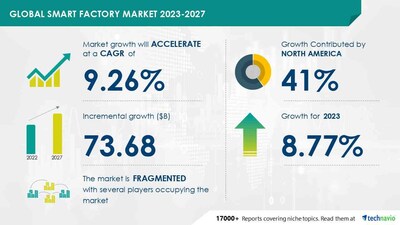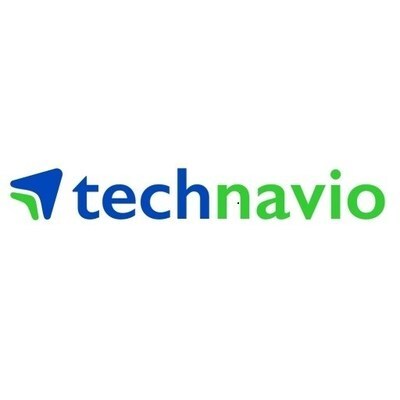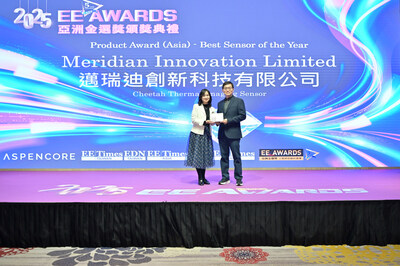Smart Factory Market size is set to grow by USD 73.68 bn from 2023-2027, need for simplification of complex manufacturing activities to boost the market growth, Technavio
Press Releases
May 13, 2024
NEW YORK, May 13, 2024 /PRNewswire/ — The global smart factory market size is estimated to grow by USD 73.68 bn from 2023-2027, according to Technavio. The market is estimated to grow at a CAGR of 9.26% during the forecast period.
For more insights on the forecast market size and historic data (2017 – 2021) – Buy Report
|
Forecast period |
2023-2027 |
|
Growth momentum & CAGR |
Accelerate at a CAGR of 9.26% |
|
Market growth 2023-2027 |
USD 73.68 billion |
|
Market structure |
Fragmented |
|
YoY growth 2022-2023 (%) |
8.77 |
|
Regional analysis |
North America, Europe, APAC, South America, and Middle East and Africa |
|
Performing market contribution |
North America at 41% |
|
Key countries |
US, China, Japan, UK, and Germany |
|
Key companies profiled |
ABB Ltd., Azbil Corp., Cisco Systems Inc., Dassault Systemes SE, Emerson Electric Co., FANUC Corp., FUJI Corp., General Electric Co., Honeywell International Inc., Johnson Controls International Plc, Microsoft Corp., Mitsubishi Electric Corp., Oracle Corp., Robert Bosch GmbH, Rockwell Automation Inc., SAP SE, Schneider Electric SE, Siemens AG, Yokogawa Electric Corp., and Endress Hauser Group Services AG |
Market Driver
In the industrial and service sectors, the IIoT and technological advancements have driven the proliferation of smart machines. These machines, utilizing high-demand smart devices, wireless, and cloud technology, will expand their utility and operation modes in the future. Vendors provide remote services and control through Wi-Fi technology, enhancing flexibility and enabling a single operator to manage multiple machines concurrently. Key trends include real-time analysis, asset utilization, investment returns, and decision-making in process industries, oil & gas, energy efficiency, and large-scale manufacturing. Smart devices enable data capture, transmission, and analysis from level, temperature, flow, pressure, force, image, and gas sensors. Engineers employ physics-based modeling to optimize employee productivity, reduce unplanned downtime, and improve product quality. Smart factories integrate HMI, smart eyewear, and IoT devices to streamline organizational design, distribution activities, strategic planning, risk mitigation, and commercial activities.
Market Challenges
- In the realm of industrial manufacturing, smart factories employ advanced technologies such as industrial robots, 5G technology, sensors, and machine learning to enhance productivity and efficiency. However, these automated systems are vulnerable to cyberattacks, posing significant risks for critical infrastructure industries like oil and gas, power, and water and wastewater. Cybersecurity concerns include data hacking and alteration, which can disrupt operations and lead to unethical data usage or manipulated processes. Key technologies, including augmented reality, virtual reality, and self-optimizing equipment, must be implemented with robust cybersecurity measures to ensure plant safety, quality control, and on-time delivery. Amidst the Covid-19 pandemic and lockdown orders, the shift to smart manufacturing technology, Industry 4.0, and increased usage of industrial robots necessitates consistent focus on cybersecurity to mitigate risks and maintain reliable connections.
Research report provides comprehensive data on impact of trend, driver and challenges – Request a sample report!
Segment Overview
This smart factory market report extensively covers market segmentation by
- Component
- 1.1 Industrial sensors
- 1.2 Industrial robots
- 1.3 Industrial 3D printers
- 1.4 Machine vision systems
- Solution
- 2.1 SCADA
- 2.2 MES
- 2.3 DCM
- 2.4 PLC
- 2.5 PLM
- Geography
- 3.1 North America
- 3.2 Europe
- 3.3 APAC
- 3.4 South America
- 3.5 Middle East and Africa
1.1 Industrial sensors- In the Smart Factory Market, industrial facilities are undergoing a digital transformation to enhance employee safety, lower operational costs, and increase process visibility. Digitalizing facilities includes the implementation of Industrial IoT (IIoT) technologies, such as sensors, artificial intelligence (AI), deep learning, computer vision, and context awareness. These advanced technologies enable data collection and analysis from smart field devices, industrial robots, and SCADA systems. Big data and cloud solutions facilitate the processing and storage of vast amounts of data. Capital investments in advanced machinery, software, IT infrastructure, and communication technologies, including 5G, are essential for the successful implementation of smart factories. The Metal & Mining industry and Aerospace & Defense sectors are major adopters of these technologies, utilizing AI, machine learning, and augmented reality for improved efficiency and productivity. However, with the increasing use of networked devices and sensors, cyberattacks pose a significant threat. IoT gateway analytics and context-aware security measures are crucial for enhancing the security of IIoT networks. Additionally, 3D printing segment is also witnessing significant growth in the smart factories market.
For more information on market segmentation with geographical analysis including forecast (2023-2027) and historic data (2017 – 2021) – Download a Sample Report
Research Analysis
In the dynamic and evolving industrial landscape, the Smart Factory Market is witnessing significant growth. This market encompasses the integration of advanced technologies such as deep learning and computer vision into manufacturing processes. Context awareness, a crucial aspect, enables these factories to adapt to varying conditions. Big data collection and analysis from SCADA systems and Industrial IoT (IIoT) are driving efficiency and productivity. Capital investments in advanced machinery, software, and IT infrastructure are essential for implementing smart factories. Communication technologies, including 5G, facilitate seamless data transfer between smart field devices and industrial robots. However, the integration of these technologies also poses cybersecurity risks, particularly from cyberattacks targeting industrial sensors. The Metal & Mining industry and Information Technology industry are key sectors embracing this transformation. Augmented reality and virtual reality technologies offer further potential for enhancing operational efficiency and safety.
Market Research Overview
In the realm of modern manufacturing, Smart Factories have emerged as a game-changer. These advanced facilities integrate Artificial Intelligence (AI), Internet of Things (IoT), and Industry 4.0 technologies to optimize production processes. The Compute Power and Data Analytics enable predictive maintenance, real-time monitoring, and efficient resource utilization. Sensors and actuators in the system provide continuous feedback, allowing for adaptive and responsive manufacturing. The Cybersecurity measures ensure data protection and system integrity. Smart Factories also facilitate just-in-time production and customization, enhancing customer satisfaction. The integration of various systems and technologies requires a robust and flexible architecture, such as the Industrial Internet of Things (IIoT) and the Smart Factory System Architecture. The implementation of these advanced technologies leads to increased productivity, reduced costs, and improved product quality.
Table of Contents:
1 Executive Summary
2 Market Landscape
3 Market Sizing
4 Historic Market Size
5 Five Forces Analysis
6 Market Segmentation
- Component
- Industrial Sensors
- Industrial Robots
- Industrial 3D Printers
- Machine Vision Systems
- Solution
- SCADA
- MES
- DCM
- PLC
- PLM
- Geography
- North America
- Europe
- APAC
- South America
- Middle East And Africa
7 Customer Landscape
8 Geographic Landscape
9 Drivers, Challenges, and Trends
10 Company Landscape
11 Company Analysis
12 Appendix
About Technavio
Technavio is a leading global technology research and advisory company. Their research and analysis focuses on emerging market trends and provides actionable insights to help businesses identify market opportunities and develop effective strategies to optimize their market positions.
With over 500 specialized analysts, Technavio’s report library consists of more than 17,000 reports and counting, covering 800 technologies, spanning across 50 countries. Their client base consists of enterprises of all sizes, including more than 100 Fortune 500 companies. This growing client base relies on Technavio’s comprehensive coverage, extensive research, and actionable market insights to identify opportunities in existing and potential markets and assess their competitive positions within changing market scenarios.
Contacts
Technavio Research
Jesse Maida
Media & Marketing Executive
US: +1 844 364 1100
UK: +44 203 893 3200
Email: [email protected]
Website: www.technavio.com/
![]() View original content to download multimedia:https://www.prnewswire.com/news-releases/smart-factory-market-size-is-set-to-grow-by-usd-73-68-bn-from-2023-2027–need-for-simplification-of-complex-manufacturing-activities-to-boost-the-market-growth-technavio-302142444.html
View original content to download multimedia:https://www.prnewswire.com/news-releases/smart-factory-market-size-is-set-to-grow-by-usd-73-68-bn-from-2023-2027–need-for-simplification-of-complex-manufacturing-activities-to-boost-the-market-growth-technavio-302142444.html
SOURCE Technavio





